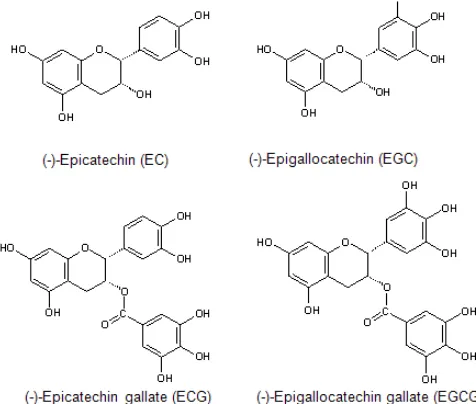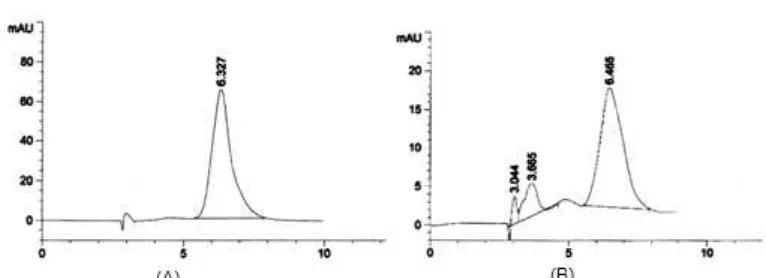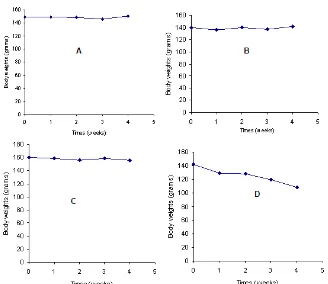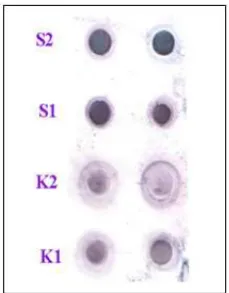Djoko Agus Purwanto et al.
* Corresponding author. Tel/Fax : +62-31-5033710/870595 Email address : djokoagus @yahoo.com
ANALYSIS OF IFN-
γ
CONCENTRATION IN WISTAR RAT BLOOD AFTER ORAL
ADMINISTRATION OF STANDARDIZED GREEN TEA WATER EXTRACT
Djoko Agus Purwanto1,*, Retno Pudji Rahayu2, and A. Toto Purnomo1
1Department of Pharmaceutical Chemistry, Faculty of Pharmacy, Airlangga University
2
Faculty of Dentistry, Airlangga University
Received April 27, 2010; Accepted August 16, 2010
ABSTRACT
Green tea and its polyphenols have been studied extensively as cancer chemopreventive agents in recent years. However, the mechanisms of action are still not clearly understood. Some researchers suggest that immune system plays important role to destroy cancer cells. Because of that reason, the present study was designed to
analyse the effects of oral administration standardized green tea water extract on increasing of IFN-γ blood
concentration and to elucidate possible mechanisms involved in the inhibitory action of the cancer development. Two groups (male and female) of 5 rats have given p.o. administration 1.25% of standardized green tea water extract and got 300 mg of (-)-epigallocatechin gallate (EGCG)/kg body weight, while two groups others (male and female) were
used as control. We found that IFN-γ blood concentration on male and female Wistar rat are significantly increase
with 13.11% and 17.59%, respectively (p<0.05) by ELISA method, whereas control had no increase. These results indicate that standardized green tea water extract has possibility to prevent and suppress cancer development
through enhancing IFN-γ expression and other immunosurveillance component.
Keywords: Green tea water extract, IFN-γ, ELISA
INTRODUCTION
Tea (Camellia sinensis) is one of the most popular beverage in the world. Tea contains many compounds, especially polyphenols, and epidemiological studies show that polyphenolic compoundspresent in tea reduce the risk of a variety of diseases [1]. Tea contains polyphenols such as catechins or flavan-3-ols including (-)-epicatechin (EC), (-)-epigallocatechin (EGC), (-)-epicatechin gallate (ECG), and (-)-epigallocatechin gallate (EGCG), as well as the alkaloid, caffeine. The structure of some tea polyphenol is shown in Fig. 1. In this study, we use green tea water extract that chemically standardized to EGCG level because EGCG is a major component of catechin in green tea and potentially has many health benefits [2-3].
Green tea has been reported to possess beneficial health activities. A population studies suggests that consumption of green or black tea beverages may bring positive health effects [4]. Many epidemiologic studies also have shown that green tea may decrease the risk of prostate cancer [5]. The cancer preventive effect of green tea is observed in pancreatic, colon and rectal cancers [6]. Green tea has been observed to decrease the risk of esophageal cancer [7]. Studies in many animal models and cell lines have demonstrated that tea and tea polyphenols possess anticarcinogenic activity [8-9]. Finally, there are reports linking the consumption
of green tea with an improved prognosis in breast cancer [10-11].
It has been reported that IFN-γ-mediated coordinated transcriptional up-regulation of TAP-1 and LMP-2 expression, which might result in enhanced recognition of renal cell carcinoma cells by the immune system [12]. IFN-γ treatment also show enhanced killing
Djoko Agus Purwanto et al.
of neuroblastoma cells by patient-derived, tumor-specific T cells in vitro. In addition, IFN-γ treatment in vivo induces efficient upregulation of major histocompatibility complex class I expression on neuroblastoma tumor cells, and this is accompanied by significantly enhanced infiltration of T cells into the tumor. In a pilot clinical trial in patients with high-risk neuroblastoma, observed augmented T-cell trafficking into neuroblastoma nests in tumor biopsy specimens obtained from patients after 5 days of systemic IFN-γ therapy. Thus, IFN-γ overcomes critical obstacles to the killing of human neuroblastoma cells by specific T cells [13].
The mechanisms of the cancer preventive effect of green tea are being explored. Although the biological activities of EGCG have been extensively studied, its immunological effects are not well known. In the recent study, the ability of standardized green tea water extract on increasing of IFN-γ concentration in Wistar rat blood was examined. This article will summarizes the most interesting result detecting of immunological effects of green tea on cancer risk prevention.
EXPERIMENTAL SECTION
Materials
EGCG was purchased from Sigma Chemical (St. Louis, MO). We used one brand of green tea sold in Surabaya. IFN-γa was measured using ELISA kits from
Bender MedSystems that suitable for mice and rats.
Wistar rat was obtained from Animal Laboratory, Faculty of Pharmacy, Airlangga University.
Instrumentation
Chromatographic separation of green tea water extract component was performed using an AGILENT
1100 series HPLC System (Agilent). The HPLC column
was a C-18 reversed-phased column Waters uBondapak, which was packed with Si 60 (particle size 10 μm, 300 x 3.9 mm). Theabsorbance of all ELISAs was read by BioRad 3550 model 96 Well Microplate Reader.
Procedure
Chromatographic Analysis of EGCG from Green Tea Water Extract
Separation of green tea water extract component and determine EGCG content was performed using HPLC methods. The solvent system for elution from the column consisted of methanol:water:acetic acid (20:75:5, by volume). Solvents were filtered through a 0.2 μm membrane filter. Separations were made at flow rate of 1.0 mL/min. The column temperature was kept constant
at 30 °C. The elution patterns were monitored at 274 nm to detect maximum absorption with Diode Array detector. The retention time (tR, in min) on that
column ranged from 2 to 10 min.
Animal Care and Treatment
Wistar rats were obtained from 3 weeks of age and adapted for 4 weeks in Animal Laboratory, Faculty of Pharmacy, Airlangga University. Each animal were housed individually in a room with controlled temperature(25 + 2 °C). After acclimationfor 4 days, rats were divided into four groups of five rats which were given free access to experimental diets. Sample experiments were given standardized green tea water extract 300 mg/kg body weight in water solution per oral. The control was made by given the same volume of distilled water. The rat consumed a fed ad libitum and had free access to distilled water for 2 weeks. Body weight was measured everyday. All procedures were performed in accordance with standards related to the care and management of experimental animals of the Faculty of Pharmacy, Airlangga University. After 4 week of feeding, rats were killed by withdrawingblood from the abdominal aorta under light diethyl ether anesthesia, and serum IFN-γ concentration was measured by ELISA.
Detection of IFN-γConcentration
IFN-γ a was measured by Enzyme-Linked
Immunosorbent Assay (ELISA) reader use of ELISA
kits (Bender MedSystems) that suitable for mice and rats. The kits were used according to manufacturers' instructions. ELISA was performed by coating 96-well polystyrene microtiterplates with aspecific monoclonal antibody. Standards and samples were addedafter the plates were blocked, and the plates were incubated overnight at 4 °C. A specific biotinylated antibody was added to all wells after they were washed, and they were incubatedfor 1 h at room temperature. The plates were washed and incubated for 30 min with horseradish peroxidase-conjugated streptavidin. After removal of nonbound horseradish peroxidase conjugate by washing, 3-3',5,5'-tetramethylbenzidine substrate reagent solution (included) was added to the wells.The reaction was stopped by the addition of 1.8 M H2SO4. Theabsorbance of all ELISAs was read at
Fig 2. HPLC chromatogram of standard EGCG (A) and sample green tea water extract (B) with ethyl acetate as eluent and methanol:water:acetic acid=20:75:5 as mobile phase by Agilent 1100 series High Performance Liquid Chromatography. EGCG has retention time (tR) at 6.327 min.
Statistical analysis
Statistical analysis of the data was performed with SPSS program 17.0 for Windows software, using
Independently Student’s t-test model. Results are
expressed as means + the SD and values of p < 0.05 were considered significant.
RESULT AND DISCUSSION
Standardization of Green Tea Water Extract
Green tea beverages are consumedevery day by billions of people in the world. The health benefits associated with green tea consumption have resulted in the wide inclusion of green tea extracts in botanical dietary supplements, which are widely consumed by some people as adjuvant for complementary and alternative medicines. Tea contains many polyphenols such as catechins including (-)-epicatechin (EC), (-)-epigallocatechin (EGC), (-)-epicatechin gallate (ECG), and (-)-epigallocatechin gallate (EGCG), as well as the alkaloid, caffeine. EGCG is a major component in green tea water extract and widely recognized as strong antioxidants. Therefore, commercial green tea dietary supplements should be chemically standardized to EGCG levels and/or biologically standardized to antioxidant capacity because different tea preparations may contain various amounts of tea polyphenols [3,14]. However, label claims on green tea dietary supplement may not correlate with actual phytochemical content or antioxidant capacity nor provide information about the presence and levels of caffeine. Only seven of the green tea dietary supplement studied made label claims of caffeine content, 11 made claims of EGCG content, and five specified total polyphenol content, while 19 commonly available green tea dietary supplement were evaluated for catechin and caffeine content [15]. In this study, green tea water extracts were standardized for EGCG content as an active major component and
analyzed using high-performance liquid chromatography (HPLC). Concentration of EGCG in standardized green tea water extract was found 4.53 + 0.03% w/w, (1.25% containing 708 ug/mL) dry base. The standard peak of EGCG was identified as the position with a retention time (tR) of 6.327 min (Fig. 2A),
while in the extract green tea, EGCG was detected at 6.465 min and low unknown peak appeared (Fig. 2B). EGCG was separated completely from other compound in sample green tea extract. In our case, the peak of EGCG has selectivity factor (α) = 1.99 and ratio of separation (Rs) = 2.85. Standard EGCG concentration ranging from 10.01 to 150.21 μg/mL and the peak area has linier correlation (r = 0.9994, p < 0.01) with variation of function coefficient (Vxo) = 2.77%.
Concentration of EGCG in sample extract green tea was found 4.53 + 0.03%. This standardized green tea water extract was used for further examination in this research.
The concentration (1.25% solution) used in this study is higher than that readily available in food sources(tea). Assuming that a cup (100 mL) of green tea contains 200–500mg of green tea polyphenols, a 70 kg human would have to consume 100–200cups of green tea to achieve an equivalent daily dose.
Effect of oral ingestion of green tea water extract on rat body weight
Before evaluation of green tea water extract administration effect on increasing IFN-γ concentration in blood, it was necessary to know body weight fluctuation of rat as long as investigation period. This condition showed stress feature of rat in that time caused by fed, treatment, room and others factor. The results show that rat body weight are relatively constant for male or female control and also male sample treatment, but decrease after 4 weeks treatment by green tea water extract for female sample rat (Fig. 3).
Fig 3. Development of control male Wistar rat body weight (A), control female body weight (B), sample male body weight (C) and sample female body weight (D) during 4 weeks green tea water extract administration
Table 1. Comparing Wistar rat body weight (BW) before and after p.o administration of standardized green tea water extracts (n=5).
Wistar rat
Average of BW Before treatment
(g)*
Average of BW After treatment
(g)*
% increasing/decreasing of BW
Control male 149 + 12 150 + 11 increase 1%
Control Female 140 + 8 142 + 15 increase 1%
Sample-Male 160 + 11 156 + 10 decrease 3%
Sample-Female 142 + 15 108 + 17 decrease 24%
*Values are mean + SD
During 4 weeks treatment by green tea water extract, rat body weight was relatively stable for all animals except sample-female that underwent 24% lost of body weight as Table 1 data. Control male, control female and sample-male body weight was not significantly change during investigation. It is remarkable that treatment by standardized green tea water extracts to Wistar rats were not make body weight fluctuation that may be affect on others investigation.
IFN-γ Concentration
The Mouse IFN-γ ELISA Kit (Bender MedSystems)
has provided 1000 pg/mL standard IFN-γ solution for making of standard curve. From that solution, it can be prepared 500, 250, 125, 63, 32, and 16 pg/mL standard solution. Each IFN-γ standard concentration has been
read triplo on ELISA Reader at wave length of 450 nm and computed the average. The relationship between absorbance and standard solution concentration were plotted on standard IFN-γ curve and can be seen at Fig. 4. The concentration of IFN-γ in the test sample was calculated from linier equation yielded by this curve.
All of rats sample were divide into 4 groups, two groups as control for male and female, and two groups remain for male and female treatment sample. IFN-γ concentration in blood was determined by ELISA method. Absorbances which were read by ELISA reader was calculated using regression equation. Increasing of IFN-γ concentration caused by green tea water extract administration can be seen at Fig. 5 and Table 2. Using Student t-test analysis, concentration of
Djoko Agus Purwanto et al.
Fig 4. IFN-γ standard curve, measured at a wave length of 450 nm by ELISA reader using Mouse IFN-γ ELISA Kit (Bender MedSystems)
Fig 5. Effects of green tea water extract administration on increasing of IFN-γ on Male and Female Wistar rat (n = 5)
Fig 6. Dot Blot results, the effects of green tea water extract administration on increasing of IFN-γ concentration on Wistar rat blood. K=K1= Control-Male rat, K2= Control-Female rat, S1=Sample-Male rat, and S2=Sample-Female rat
IFN-γ in both male and female Wistar rat increase significantly (p < 0.05) by 13.11% and 17.59%, respectively.
The Dot Blot results shown that there are
increasing intensity of color on samples S1 and S2 compared with control K1 and K2 (Fig. 6). These results give positive correlation with increasing of IFN-γ concentration in rat blood after green tea water extract exposure analyzed by ELISA. Both male and female rat underwent enhancing of color intensity.
IFN-γ is a pleiotrophic cytokine with immunomodulatory effects on a variety of immune cells that responses play an important role in antiviral defense. Antiviral antibodies prevent the spread of viral infectionsthrough two main mechanisms: (a) block of interactions of viral surface proteins (Env) with their receptors; (b) facilitationof virus uptake into phagocytic cells through interaction with the Fc receptors or through the complement pathway. Although for many viral infections antibody production is a key to clearance retroviruses such as HIV are able to escape humoral immuneresponses despite the fact that anti-HIV antibodies are beingproduced [16-17]. Deficient in IFN-γ had also impaired production of macrophage antimicrobial products and reduced expression of macrophage major histocompatibility complex class II antigens.
Matsunaga and his team found that EGCg was also demonstrated upregulation of the levels of macrophage gamma interferon (IFN-γ) mRNA in the macrophage cultures infected with L. pneumophila [18]. Documented evidence favors the idea that, among all known STATs, STAT1 has a predominant growth cell inhibition [19], consistent with the well-documented antiproliferative action of IFN-γ [20-21]. Menegazzi and colleagues showed that EGCG blocked IFN-γ–induced STAT-1 activation in carcinoma-derived cell lines of non-gut origin [22].
CONCLUSION
Our results show that standardized green tea water extract increases IFN-γ concentration significantly in Wistar rat blood analyzed by ELISA method. These results indicate that green tea has possibility to prevent and suppress cancer development through enhancing IFN-γ expression.
ACKNOWLEDGEMENT
Djoko Agus Purwanto et al. REFERENCES
1. Wu, A.H., Yu, M.C., Tseng, C.C., Hankin, J., and Pike, M.C., 2003, Int. J. Cancer, 106, 4, 574–579. 2. Fujiki, H., 2005, Chem. Rec., 5, 3, 119–132.
3. Navindra, P.S., Susanne, M.H., Niu, Y., Rupo, L., Samuel, S.H., and Heber David, H.H., 2006, J. Agric.
Food Chem., 54, 1599–1603.
4. Peters, U., Poole, C., and Arab, L., 2001, Am. J.
Epidemiol., 154, 6, 495–503.
5. Jian, L., Xie, L.P., Lee, A.H., and Binns, C.W, 2004,
Int. J. Cancer, 108, 1, 130–135.
6. Ji, B.T., Chow, W.H., Hsing, A.W., McLaughlin, J.K., Dai, Q., Gao, Y.T., Blot, W.J., and Fraumeni, J.F., Jr., 1997, Int. J. Cancer, 70, 3, 255–258.
7. Gao, Y.T., McLaughlin, J.K., Blot, W.J., Ji, B.T., Dai, Q., and Fraumeni, J.F., Jr., 1994, J. Natl. Cancer Inst., 86, 11, 855–858.
8. Yang C.S., and Landau J.M., 2000, J. Nutr., 130,
2409–2412.
9. Yang, C.S., Maliakal, P., and Meng, X., 2002, Annu.
Rev. Pharmacol. Toxicol.,42, 25–54.
10. Nagata, C., Kabuto, M., and Shimizu, H., 1998, Nutr.
Cancer, 30, 21–24.
11. Nakachi, K., Suemasu, K., Suga, K., Takeo, T., Imai, K., and Higashi, Y., 1998, Jpn. J. Cancer Res.,
Bowman, T., Garcia, R., Turkson, J., and Jove, R. 2000, Oncogene, 19, 2474–2488.
12. Seliger, B., Hammers, S., Höhne, A., Zeidler, R., Knuth, A., Gerharz, C.D., and Huber, C., 1997, Clin.
Cancer Res., 3, 573–578.
13. Reid, G.S.D., Shan, X., Coughlin, C.M., Lassoued, W., Pawel, B.R., Wexler, L.H., Thiele, C.J., Tsokos, M., Pinkus, J.L., Pinkus, G.S., Grupp, S.A., and Vonderheide, R.H., 2009, Clin. Cancer Res., 15, 21, 6602–6608.
14. Dong, Z., Ma, W., Huang, C., and Yang, C.S., 1997,Cancer Res., 57, 4414–4419.
15. Seeram, N.P., Henning, S.M., Niu, Y., Lee, R., Scheuller, H.S., and Heber, D., 2006, J. Agric.
Food Chem., 54, 5, 1599–1603.
16. Ochsenbein, A.F., and Zinkernagel. R.M., 2000.
Immunol. Today, 21, 624–630.
17. Miedema, F., Meyaard, L., Koot, M., Klein, M.R., Roos, M.T., Groenink, M., Fouchier, R.A., Van't Wout, A.B., Tersmette, M., and Schellekens, P.T., 1994, Immunol. Rev., 140, 35–72.
18. Matsunaga, K., Klein, T.W., Friedman, H., and Yamamoto, Y., 2001, Infection and Immunity, 69, 3947–3953.
19. Bowman, T., Garcia, R., Turkson, J., and Jove, R., 2000, Oncogene, 19, 2474–2488.
20. Fujiki, H.J., 1999, Cancer Res. Clin. Oncol., 125, 589–597.
21. Conney, A.H., Lu, Y., Xie, J., and Huang, M., 1999,
Proc. Soc. Exp. Biol. Med., 220, 229–233.



